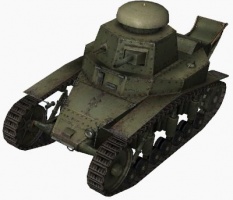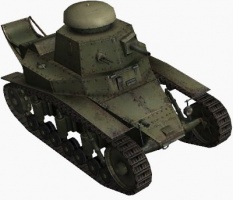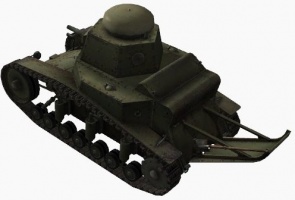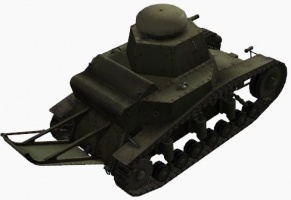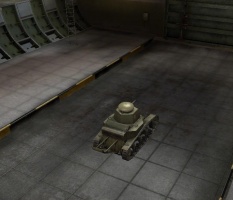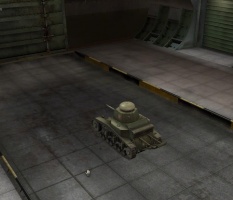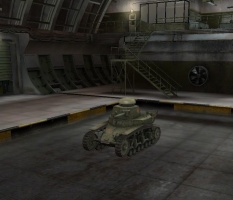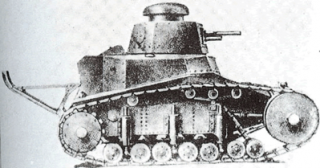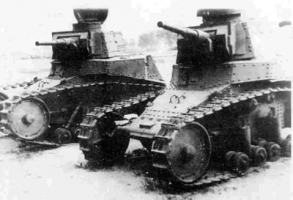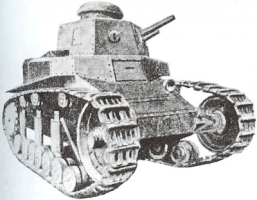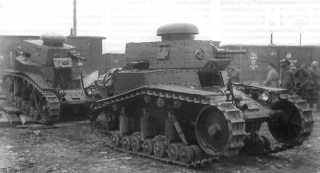MS-1
MS-1
Mouse over "
[Client Values; Actual values in
| 0 |
| 21543 HP Hit Points |
| 4.76/6.52.15/6.5 t Weight Limit |
- Commander (Gunner, Radio Operator, Loader)
- Driver
| 5555 hp Engine Power |
| 32/8 km/h Speed Limit |
| 4848 deg/s Traverse |
| 11.5525.58 hp/t Power/Wt Ratio |
| NoNo Pivot |
| // mm Hull Armor |
| 16/16/1616/16/16 mm Turret Armor |
AP/HEAT/HE
AP/APCR/HE Shells |
0/400/8
14/800/14 Shell Cost |
| 30/30/3647/47/62 HP Damage |
| 34/44/1951/88/23 mm Penetration |
|
24 r/m ▲
20.69 r/m Standard Gun ▲ Rate of Fire Standard Gun |
|
720 ▲
Standard Gun
▼
Standard Gun
▲
972.43 Standard Gun ▲
Standard Gun
▼
Standard Gun
▲ Damage Per Minute Standard Gun |
|
0.54 m ▲
0.46 m With 50% Crew: 0.687 m ▲ Accuracy With 50% Crew: 0.585 m |
| 2.5 s 2.5 s Aim time |
| 3535 deg/s Turret Traverse |
| 360° Gun Arc |
| -8°/+25°-8°/+30° Elevation Arc |
| 240125 rounds Ammo Capacity |
| 2020 % Chance of Fire |
| 280 m 280 m View Range |
| 265 m 265 m Signal Range |
I
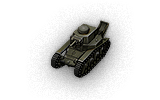
0
The MS-1 is a Soviet tier 1 light tank.
The first Soviet mass-produced tank with a total of 959 vehicles manufactured from 1928 through 1931.
It is the smallest and lightest of the tier 1 tanks. The vehicle possesses features that make it visually and audibly unique; the MS-1 has external features which resemble a "hat" and "tail", and the engine makes a distinctive "puttering" sound. When equipped with the 45 mm mod. 1932 gun, it has the damage potential to kill any other tier 1 tank in approximately three shots. This damage rate, when combined with the 45 mm gun's penetration (superior to all other weapons found on tier 1 tanks), makes the MS-1 a formidable opponent in tier 1 battles.
Modules / Available Equipment and Consumables
Modules
| Tier | Suspension | Load Limit (т) |
Traverse Speed (gr/sec) |
Rmin | Weight (kg) |
Price (
| |
|---|---|---|---|---|---|---|---|
| I | T-18 | 6.5 | 48 | B/2 | 1200 | 0 |
Compatible Equipment
Compatible Consumables
Player Opinion
Pros and Cons
Pros:
- Good armor (for a tier 1 tank).
- The 45 mm mod. 1932 gun has the highest penetration value in tier 1, as well as acceptable accuracy and good damage.
- Decent hull traverse and excellent turret traverse speeds.
- Small size and good camouflage values, making it easy to hide and difficult to detect and hit.
Cons:
- Lowest HP of all the tier 1 tanks.
- Fairly slow.
- Long aim time.
- Poor view range.
Performance
The MS-1 is a very capable and forgiving tier 1 tank, making it an excellent starter vehicle. Stock, it is slower and weaker than the American and German starter tanks, but it has the thickest armor. The frontal armor is almost twice as thick as the T1 Cunningham's (although 18 mm of armor is not going to stop much incoming fire). Against this, the MS-1 has the lowest HP of all the tier 1 tanks, and cannot take too many hits.
The starting gun, the 37 mm Hotchkiss, is decent enough against other tier 1 tanks, but is very inaccurate. The 45 mm mod. 1932 is the probably best single-shot weapon available to any tier 1 tank. It has the highest damage and penetration for its tier, effectively penetrating all but the most heavily armored tanks the MS-1 faces. Sniping with this gun can be very effective. The high damage per shot also makes it excellent for taking "snap shots" while playing "peek-a-boom" (moving out of cover, taking a quick shot at close range, then moving into cover again). Both of the single-shot guns have very long aim times (2.5 seconds), with only the QF 3-pounder on the Vickers Medium Mk. I having a longer aim time.
The MS-1 has the lowest horsepower of all the tier 1 tanks, and is one of the slowest for its tier. It is decently maneuverable, with fair hull traverse and excellent turret traverse speeds, but can have trouble climbing steep slopes. Combined with the excellent single-shot guns it can equip, these factors make the MS-1 well-suited to a more careful and deliberate play style, as opposed to the more aggressive play styles of the Leichttraktor or T1.
The MS-1 is also one of the smallest tanks in the game, making it much more difficult to both detect and hit, compared to the other tier 1 tanks. With a Camouflage Net, it is nearly undetectable until it fires.
Please note the Map Restrictions for tier 1 tanks when purchasing a camouflage skin/paint job for the MS-1.
Crew Skills
- Choosing Camouflage for both crew members as their first skills can turn the MS-1 into a near-invisible tank.
- The combination of Snap Shot (Commander/Gunner/Radio Operator/Loader) and Smooth Ride (Driver) are other viable options for first skills, allowing the MS-1 to get its shot off faster after coming to a halt.
- Upon reaching 100% on the first skills, one can drop the commander's skill for Sixth Sense, allowing the tank to be alerted after being detected.
- Brothers-in-Arms will improve the tank's performance, but requires all crew members to have it at 100% before it works. The bonus to crew skills is particularly noticeable when combined with Improved Ventilation.
Early Research
- The 45mm cannon is the only module available for research, so get that.
Suggested Equipment
Gallery
Historical Info
First Renault FT tanks came to Russia on December 12th, 1918. 20 vehicles, as a part of 3rd company of the 303rd assault gun regiment, arrived at Odessa, along with French and Greek forces. On March 18th, 1919, 4 of them were captured in battle next to the Berezovksaya station, close to Odessa. The interventionist forces fled from the battle, and Nikifor Grigoriyev's 1st Transdniepr Brigade collected the rich bounty. One tank was sent to Moscow as a personal present to Lenin. The remaining three were sent to Khrakov (the capital of Soviet Ukraine at the time). Lenin liked the "French novelty", and wanted to display it at the May 1st parade in Moscow. For this, another tank was requested from the Ukraine (the first was missing parts, and immobile). The second tank arrived in Moscow in the last week of April. Former aviator B. Rossinskiy was assigned as its mechanic. He figured out the unfamiliar machine in one night, and, with two assistants, put the two tanks together into a functioning one. The government decided to mass produce Renault FTs in the RSFSR, and, on August 10th, by the decision of the SovNarKom and Council of Wartime Manufacturing, the Krasnoye Sormovo factory in Nizhniy Novgorod became a specialized tank producing establishment.
The tank that took part in the parade was shipped to the factory on September 29th, 1919. It was disassembled and spread among three railroad cars. The tank did not arrive in full: several components were stolen on the way. The lack of a gearbox proved an unfortunate surprise for the engineers. N.I. Hrulev and P.I. Saltanov led a special team of engineers, tasked with re-designing the missing components and setting up mass production of the tanks. The project was completed in four months, and the construction of "Russian Renault" tanks began in December. In 1920-21, 15 tanks were built, each with a name. The first, and most famous, was named "Comrade Lenin, Freedom Fighter", and gifted to Trotsky, who was the head of the Revolutionary Military Council at the time. The tanks differed from the French ones in armament, with French guns replaced by ones available in the young country. The hexagonal turret was produced with no changes, even through in France, the Renault FT already had a modernized conical turret. Due to the lack of a manufacturing base, the release was limited to 15 vehicles. Armoured units in the Red Army were largely equipped with captured British tanks.
In the Spring of 1924, the Tank Bureau of the Chief Directorate of Military Manufacturing was formed, and, on May 6th, started work. None of the engineers had any experience with designing armoured vehicles, and they completely lacked documentation. In September of 1926, a meeting between the RKKA command, Chief Directorate of Military Manufacturing, and Cannon Armament Group took place, in order to determine requirements for new armoured vehicles for the Red Army. Various foreign tanks were reviewed, to judge their worth as a basis for a new tank. The French Renault FT was capable of infantry support, but, according to those present, it had a series of serious flaws. The Italian FIAT 3000 was a more satisfactory prototype, with a higher speed and lighter mass. The tank was studied by Tank Bureau engineers since 1925, as a part of a project for a new 3-ton light tank. The OAT Construction Bureau (formerly Tank Bureau), showed that the tank meets most requirements, but lacks a cannon, and needs an engine of at least 35 hp. The tank that was to be created was indexed T-16.
In March of 1927, the first T-16 drove out of the gates of the experimental design bureau of the Bolshevik factory (formerly the Obuhov gun and steel factory). Compared to the Russian Renault, it was shorter, lighter, more mobile, and much cheaper (the Russian Renault cost 36 000 Russian Rubles). Compared to the FIAT 3000, the engine, suspension, and armament were changed. The Fiat gasoline engine (AMO produced clones of it for the Russian Renault) was replaced with a new one, created by the talented engineer A.A. Mikulin, who worked at the Scientific Auto-Motor Institute at the time. Trials of the T-16, however, revealed faults in the engine and suspension. The second prototype, indexed T-18, was finished in May of the same year. The tank underwent trials between June 11-17 of 1927, next to the village Romashkova and railroad station Nemchinovka, only in its cross-country capability, as the gun was not yet ready. Trials were successful, and the tank was accepted under the index "Small support tank model 1927" (MS-1). First 30 vehicles were paid for by the Osoaviahim organization, and took part in the November 7th, 1929 parade under the unofficial slogan "Our answer to Chamberlain".
In total, 959 MS-1 tanks were produced from 1927 to 1932. 4 of them were sent to the OGPU, 2 - to the Fourth Directorate, and one to the Military Chemistry Directorate of the Red Army. The tanks were assembled into tank battalions, and larger mechanized units (regiments and brigades). The MS-1 was actively used to train troops. The first 103 vehicles were immediately given to Osoaviahim and other military academies). The first serious trial of the MS-1 was the Large Bobruisk Manoeuvres of 1929. Despite the harshness of the manoeuvres, the tanks successfully completed them, although not without minor breakdowns. Those breakdowns were the cause for the modernization of the tank in 1929-30. The modernization objectives were to increase the speed to at least 25 kph, install a high power 37 mm gun, replace the machine gun with a more modern one. The turret was completely redone, the commander's cupola was improved, and the tank received a bay in the rear of the turret for a radio station.
10 MS-1s took part in the conflict at the East China Railroad. The Transbaikal Group of the Independent Far East Military District contained 6091 infantry, 1599 cavalry, 88 guns of 76.2 mm caliber or higher (not counting regimental artillery), 32 airplanes, 3 armoured trains, and 9 T-18 tanks (10 arrived in Chita in the fall of 1929, but one was heavily damaged during offloading and was taken apart for spare parts). Despite suboptimal organization, lack of fuel and ammunition, the performance of the company was judged as adequate. However, the drivers were insufficiently trained, commanders did not know how to find their way, and had no communication between each other. The tank's gun was inadequate against fortifications. The machine guns, however, were an effective means of demoralization and destruction of the enemy. Requests were made for a larger caliber gun, more machine guns, better off-road performance, more speed, more armour. Tank forces had a long way to go before they would be the most effective method of war in the mid-20th century.
The MS-1 served as a basis for specialized vehicles. Due to its rapid obsolescence, many of these did not advance past blueprints and experimental prototypes. There was a chemical tank, for putting up smokescreens. A tank called TT-18 was tested as a remote controlled tank (self propelled mine, chemical warfare vehicle). Various projects for tankettes, APCs, assault guns, and engineering vehicles never left the drawing board. The SU-18 project, which will be definitely discussed later, was developed. Elements of the MS-1 can be found in Soviet tractors of that era.
The modernization of the tank in 1938 did not result in much improvement, and the question of retiring the MS-1 arose. By that point, 862 vehicles remained of the original 959. The rest were either taken apart or scrapped. The tanks were re-armed with 45 mm model 1932 guns. Tanks that completely exhausted their mobility resources were taken to fortification regions, and dug into the ground as stationary gun emplacements. Still mobile MS-1s were assigned to these regions as mobile artillery. Several MS-1s in various stages of combat readiness are spotted in photographs taken by advancing Germans in 1941.
There is little record of MS-1s fighting in WWII. The Osovets (#66) fortification region had 36 armoured turret emplacements (including MS-1s) with 45 mm guns, and two tank companies (1st, with 25 MS-1s, at Kolno, and 2nd, with 18 MS-1s, at Belyashevo). The second company successfully fought German armoured vehicles, most of which were armoured cars and light tanks. There is evidence that MS-1s took part in the Battle of Moscow in the fall and winter of 1941. The MS-1 was replaced in its support role by the T-26, which was adopted in 1931.
No more than 20 MS-1s survive to this day, as a part of museum exhibits and monuments. Hulls and spare parts are occasionally found by archaeologists, and a number of these vehicles are currently being restored. Due to the MS-1s that met the war as immobile turrets, there are serious problems with restoring their own suspension. Not a single original track link has been found, original road wheels and shock absorbers are scarce. Due to this, the suspension of all restored MS-1s is not original.




